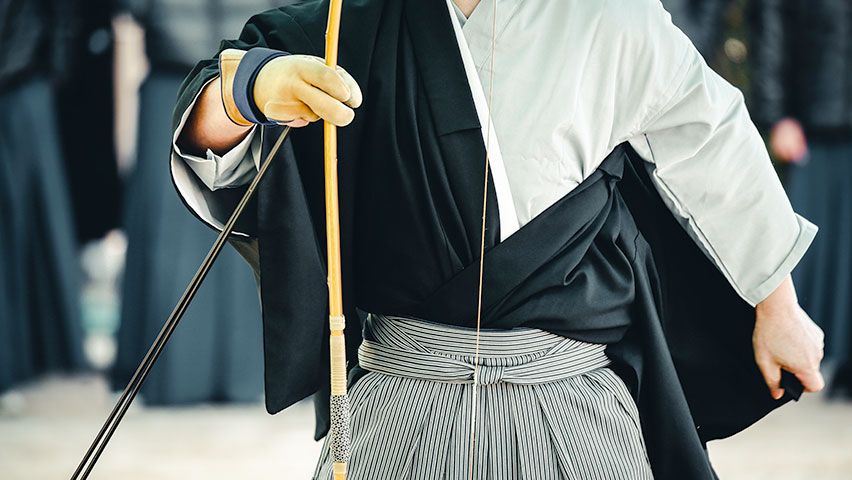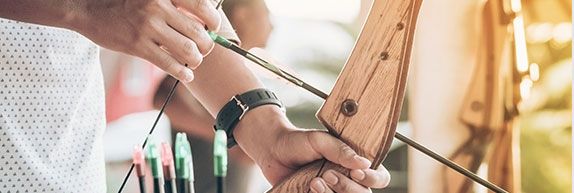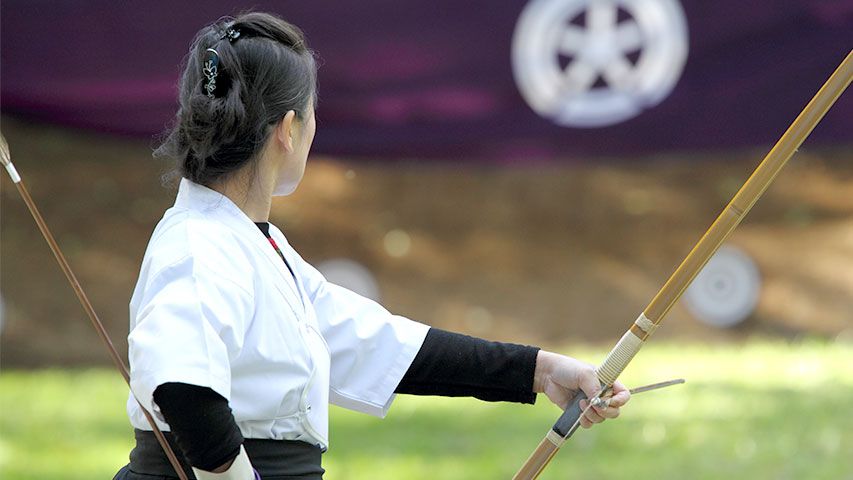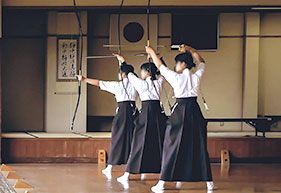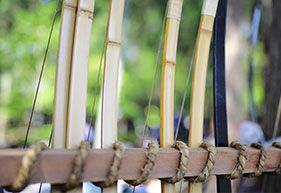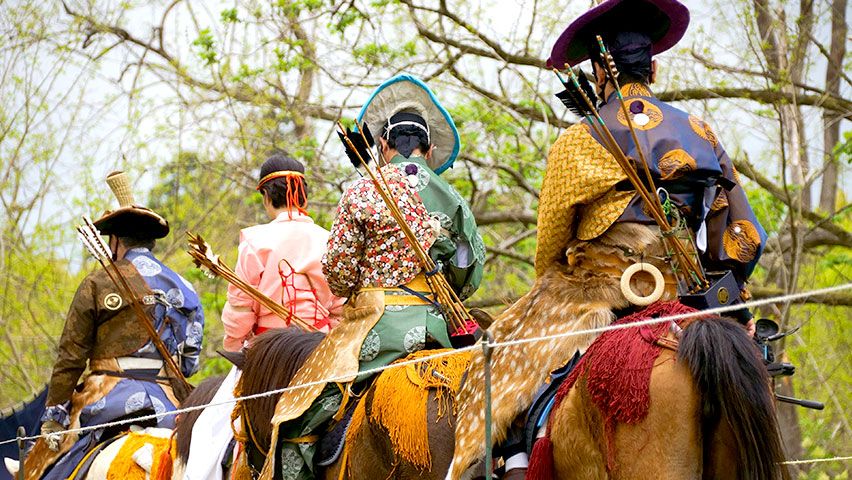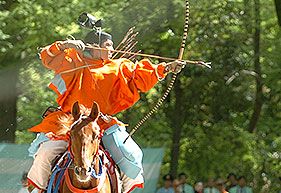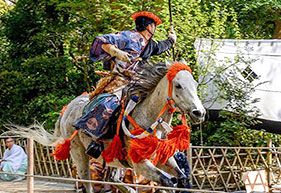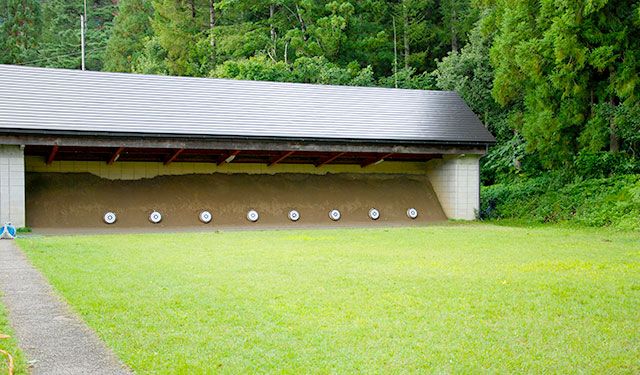- TOP
- Practice Archery
About KYUDO
Japanese Martial Arts: Archery
Kyudo (literally the Way of Archery) is one of the oldest traditional martial arts and the most closely associated with Zen. It is a noble and refined martial art and is considered also as a graceful exercise.
Kyudo practices and contests still have a wide following throughout Japan. It is pursued by almost as many female students as males. Virtually most high schools and universities in the country have kyudo clubs. Schools and exercise halls are often closely linked with shrines and temples as well, and Kyudo has come to figure significantly in the religious life of the Japanese.
The Japanese bow (Kyu or Yumi) measures 2.25 meters from tip to tip. It is made with strips of bamboo and mulberry wood, and lacquered. Practice is done in the Hakama, or split skirt. In practice, every movement is rigidly prescribed, with no room for random action from the time one takes his place before the target until he leaves. Ogasawara and Heki are two of the most famous Kyudo schools originating around 1380.
Kyudo
Differences between Kyudo and Western Archery
Kyudo is a competition in which we use the Japanese Bow and compete whether the arrow hits the target or not.
Archery uses the western bow and arrow in a competition to hit as close to the center of a target as possible.
Japanese bows are unparalleled compared in length to other archery bows.Western archery may be practical as its bows are shorter and designed to shoot longer with the strength while Japanese bows possess beauty and artistry in its distinguishing features.
As it comprises a large sphere in the world of the spirit and mind, it was also used in religious rituals.
Basically, both of the practice aims to hit a stationary target.In the competition of archery, how many targets you hit and its preciseness is what matters, but in Kyudo the process of shooting is important as equally as the hitting target, or even more so.
Spirit of KYUDO
While much of Kyudo tradition is derived from ancient Shinto practice, Zen became a powerful influence in the 12th and 13th centuries as warrior archers looked to Zen for their moral code. In the 17th and 18th centuries, while Japan was experiencing a period of peace, Zen became an even greater influence and the philosophical side of Kyudo became more developed.
After guns were introduced into Japan, the age of warfare using bows and arrows ended and archery became a form of training of the body and mind. This lead the art of archery to become more refined through this transition.
In modern times,The mission of modern Kyudo is a form of moving meditation and a unique martial art. The goal is not to hit the target, but to open one's heart and spirit to the technique. When all is in balance, the arrow will reach the target.
The target becomes a mirror reflecting the quality of one’s mind at the moment of the arrow’s release.
Yabusame
The combat form of bowmanship derives from the Samurai, or warrior class, who were the only ones allowed to carry and use weapons. The bowmen of the Samurai were especially respected and effective as they wore armor and shot from horseback.
As far back as the 7th and 8th centuries, a complicated ceremonial form of archery was practiced by the Japanese imperial court. This form of bowmanship has its roots in the Shinto religion and is rarely known or practiced outside Japan.
Yabusame or archery on horseback was performed as a ceremony by courtiers or Imperial guards in around the 7th century. In the turbulent Kamakura days of the early 12th century, it was promoted by the then shogunate government to develop martial spirit among the warriors.
Yabusame today is a Shinto rite for ensuring peace and good harvests and dispelling evil spirits. It is staged by horsemen dressed in colorful traditional costumes who gallop down a narrow, 250-meter course, shooting at three small wooden targets set up at 80-meter intervals.
Yabusame is still an annual event at several shrines, but the best known of these is held at the Tsurugaoka Hachimangu Shrine in Kamakura on the 3rd Sun. of April and September 16, and at Shimogamo Shrine in Kyoto on May 3rd.
History
The origin of the bow dates back a long time in history. Bows were already in use by ethnic groups in the Middle East and Asia during the end of the Stone Age.
In Japan, artifacts of bows likely to be from the same period have been discovered as well. It is estimated that they were made between AD1 to AD3 during the Yayoi Period. These bows were maruki-type long bows made from a single piece of wood; painted in black and bound by birch. Also, in depictions of hunting scenes drawn on bell-shaped bronze vessels, a long bow with a grip can be identified.
It is mentioned in the Gishi-Wajin Den (Record of the Wei-Biography of the Wajin) that bows used by the ancient Japanese were long bows. This description, along with what is written in the Kojiki (Ancient Chronicles of Japan) prove that bows held a significant meaning, both ideologically and culturally in the Ancient Japanese world and were looked upon as a symbol of dignity. Thus, they played an important role in Shinto and Samurai rituals in later years.
In China, there are many books referring to the bow such as The Rites of Zhou and The Book of the Later Han. However the most significant work to influence the use of the bow in ceremonies was introduced in the "Liji" (Record of Etiquette). Diplomatic relations between China and Japan started around the 4th and 5th century after Emperor Ohjin's reign. The Chinese influence on Japan expanded into many areas. The original Japanese thought of itoku (dignity and virtue), met with the Chinese thought of rei (courtesy) lead to form the Sharei (shooting ceremony) in the imperial court and in the later years, it became the thought of courtesy in the samurai ways of the bow. In China, bows were seen as the most dignified weapon - a weapon for kings and lords. This thought eventually was integrated into the Japanese Samurai.
The Fuse-takeyumi (Lowered Bamboo Bow) made in mid-Heian Era (10th century) and Sanmaiuchi-yumi (Bow made from three pieces) made in the late-Heian Era (12th century) are composite bows made from bamboo and wood. The technique was brought into Japan from China.
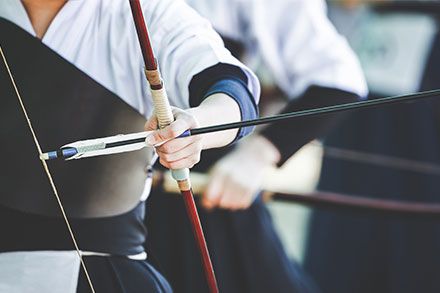

When Yoritomo no Minamoto founded the Kamakura Shogunate in 1192, he established the Samurai Ethic, stating that a samurai must devote himself to reaching a spiritual height by mastering the art of horseback archery. This was taken from Azuma Kagami (Mirror of the East), a history book written in the Kamakura Period, that various forms of horseback archery such as Inuoumono (dog hunting) and Kasagake (hat shooting) were well-practiced to train the body and mind of the samurai during this age.
At Tsurugaoka-Hachimangu Shrine, Yabusame (horseback archery) is performed as a part of the Hojoe ritual up to this day. Makigari hunting became extremely popular during the Kamakura era, and bows that held more of a ritual meaning in the Heian Era regained their role in warfare. However; Inuoumono and Kusajishi (grass deer target archery) with their strict rules developed as sporting events.
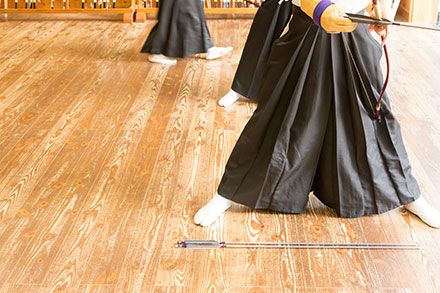
Archery took innovative strides during the decades of conflict that started from the Period of North and South Dynasties up to the Muromachi Period.
During Emperor Godaigo's reign, Sadamune and Tsuneoki Ogasawara compiled the way of the bow that were handed down and practiced within the Samurai community and established the foundation of the school for Japanese horseback archery. Later on, the Ogasawara family was engaged as the grand master of horseback archery up until the Edo Period. How archery was practiced in those days is described thoroughly in the Ryoshun Ozoushi written by Ryoshun Imagawa. Danjoh Masatsugu Heki, the founder of the Heki School is also from this period. The Heki School spread as archery become most fit for actual combat. Masatsugu's style was passed on to his disciple, Shigekata Yoshida, and then split to two schools, Sekka and Izumo. From the Sekka School, Dosetsu, and from the Izumo School, Insai and Okura. Because of these gifted predecessors, the art of archery advanced rapidly.
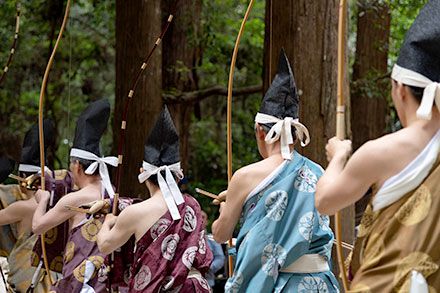
Years later a lateral branch, the Chikurin School, originated by Josei Chikurinbo was established and commonly practiced in the Owari and Kishu areas. Many schools deriving from others were also established during the 150 years between the 15th and 17th century (the end of Muromachi Period and the beginning of Edo Period).
Major schools such as the Yamato School by Kozan Moriyama in the Genroku Period and the Honda School by Toshiazane Honda in the Meiji Era were founded thereafter.
The innovation in the art of Japanese archery is described in Takatada Kikigaki written by warlord, Takatada Taga. In his book, there is mentioning of the pros and cons of yugaeri (turning of the yumi), a technique enabled by the curved bow.
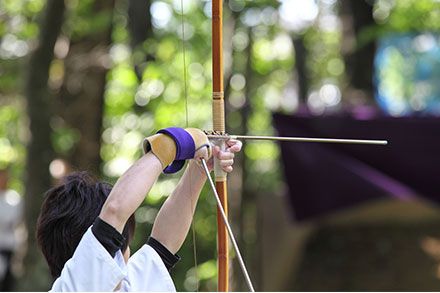
Gallery
Practice Archery
The correct application of the criterion of shooting technique to the process of shooting is known as
the Shaho (Principles of Shooting). For training in Kyudo, it is first of all, essential to have a good
understanding of the criterion determined by the Shaho.
Shaho-Hassetsu
The shahō hassetsu are the eight stages of shooting an arrow, which are
compared to eight joints on a bamboo pole.

Step1
Ashibumi
Placement of the feet.

Step2
Dōzukuri
Correcting the posture of the upper body.

Step3
Yugamae
Readying the bow and fixing the arrow.

Step4
Uchiokoshi
Raising the bow.

Step5
Hikiwake
Drawing the bow.

Step6
Kai
full draw, harmony of body and spirit waiting for the moment to shoot.

Step7
Hanare
Hatural release when the moment is ripe.

Step8
Zanshin
Maintenance of posture after shooting and remaining form(spirit)
About the Archery Court
The archery court is located across the street
about 20 to 30 seconds on foot from the hotel.
-
1The entire view of the archery court, with straw targets "MAKIWARA" in front (7 years old).
-
2The archery court is across the road from the hotel.
-
3On the left in the back is our hotel.
-
1
-
2
-
3
Click here for inquiries
Please feel free to contact us for
requests and questions or if you are interested in japanese archery.


